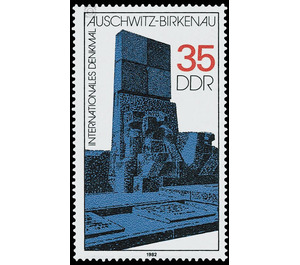international reminders and memorials - Germany / German Democratic Republic 1982 - 35 Pfennig
Theme: Architecture
| Country | Germany / German Democratic Republic |
| Issue Date | 1982 |
| Face Value | 35.00 |
| Color | blue |
| Perforation | K 14 |
| Printing Type | Rotogravure 2 |
| Stamp Type | Postage stamp |
| Item Type | Stamp |
| Chronological Issue Number | 2477 |
| Chronological Chapter | GER-DDR |
| SID | 160171 |
| In 13 Wishlists | |
Auschwitz-Birkenau International Memorial With a picture of the Auschwitz-Birkenau International Memorial, the Ministry of Posts and Telecommunications of the German Democratic Republic issues a special postage stamp. Special cancellation from 7th September to 6th November 1982 Monument Auschwitz-Birkenau The monument shown on the postage stamp stands on the grounds of the former extermination camp Auschwitz-Birkenau near Oswiecim in the People's Republic of Poland. Designed by Pietro Cascella, Giorgio Simoncini, Jerzy Jarnuszkiewicz and Julian Paka, it was inaugurated on 16 April 1967 in memory of the four million victims of Auschwitz. The concentration camp Auschwitz was built in 1940 to suppress the Polish people and served since 1942 in addition to the industrial mass destruction of Jews. In terms of area and number of prisoners, it was the largest of all Hitlerite-fascist concentration camps with the camp complexes Auschwitz I (main camp), Auschwitz II (extermination camp Birkenau) and Auschwitz III (Monowitz and about 30 smaller external camps). Total number of inmates on August 22, 1944: 135,000. After Auschwitz, the fascists abducted some 4.4 million men, women, and children, especially from Poland and the Soviet Union, as well as Jews and Gypsies from all Hitler occupied countries. More than four million of them died as a result of the inhuman living and working conditions or were slain, shot, hanged, killed by phenol injections or in the gas chambers. The bodies were burned in a small crematorium at the main camp, in open fire trenches and in four large crematoria in Birkenau. In armaments factories (IG colors, Krupp, Siemens) or coal mines the prisoners were pressed to heaviest work. Those who were no longer able to work were "selected" and eliminated for guest use. In Auschwitz I, SS doctors (Clauberg, Mengele, and others) performed pseudo-medical experiments on prisoners, eg, B. for mass sterilization. Prisoners from almost all European countries organized anti-fascist resistance in all camp complexes and many satellite camps - eg. T. with the help of the surrounding population. After evacuation of the camp by a lossy death march of all able-bodied prisoners on January 27, 1945, about 7,500 surviving prisoners were released by the Red Army.


